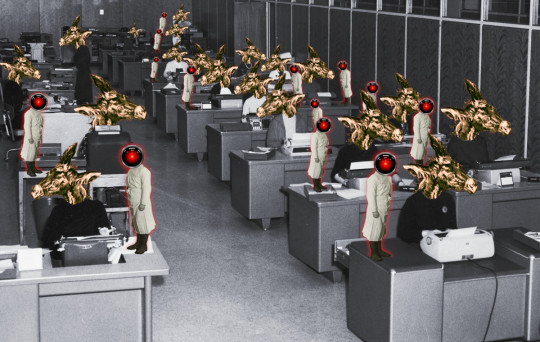#lab technology
Explore tagged Tumblr posts
Text
https://www.vjinstruments.com/blog/revolutionizing-pharmaceutical-research/
Revolutionizing Pharmaceutical Research – Advancements in Lab Technology by VJ Instruments
Discover how VJ Instruments is transforming pharmaceutical research with innovative lab equipment. From precision drug delivery systems to advanced drying technologies, learn how these cutting-edge tools are accelerating drug development and ensuring higher safety standards. Stay ahead in the pharmaceutical industry with insights from VJ Instruments
0 notes
Text
Unlocking Opportunities: A Market Analysis of Lab Services Providers in Indonesia
Lab services are an essential part of the healthcare industry. They provide diagnostic tests and analytical services to help doctors diagnose and treat patients. In Indonesia, the lab services market has been growing steadily, driven by factors such as an increasing prevalence of chronic diseases, rising healthcare expenditure, and growing awareness among people about the importance of early disease detection.
Write to us at [email protected] learn how GRG Health is helping clients gather more in-depth market level information on such topics.
In this blog article, we will provide a market analysis of lab services providers in Indonesia, including the current state of the market, major players in the industry, and the key trends and challenges facing the industry.
Current State of the Market
The lab services market in Indonesia has been growing at a CAGR of 12% over the past few years and is expected to continue to grow at a similar rate in the coming years. This growth can be attributed to various factors such as an increasing number of private healthcare providers, rising healthcare expenditure, and growing awareness about the importance of early disease detection.
Major Players in the Industry
The lab services market in Indonesia is highly fragmented, with several players operating in the market. Some of the major players in the industry include Prodia, Kimia Farma Diagnostika, Cito Diagnostics, and Klinik Laboratorium Klinik Pratama.
Prodia is the largest lab services provider in Indonesia, with a market share of around 20%. The company operates over 150 labs across the country and offers a wide range of diagnostic tests and analytical services.
Kimia Farma Diagnostika is another major player in the market, with a market share of around 15%. The company operates over 100 labs across the country and offers a range of diagnostic tests, including molecular diagnostics and pathology.
Cito Diagnostics and Klinik Laboratorium Klinik Pratama are relatively smaller players in the market but have been growing steadily over the past few years. Cito Diagnostics specializes in radiology and imaging services, while Klinik Laboratorium Klinik Pratama offers a range of diagnostic tests, including hematology, microbiology, and immunology.
Key Trends and Challenges Facing the Industry
One of the key trends in the lab services market in Indonesia is the increasing adoption of digital technologies such as telemedicine and mobile health. This has enabled lab services providers to offer their services remotely and has also improved patient engagement and satisfaction.
Another trend in the industry is the increasing focus on personalized medicine. Lab services providers are investing in new technologies such as genomics and proteomics to provide personalized diagnostic and treatment solutions to their patients.
However, the lab services market in Indonesia also faces several challenges. One of the major challenges is the lack of skilled professionals, which has led to a shortage of trained technicians and scientists. This has resulted in longer wait times for test results and has also affected the quality of services provided by some lab services providers.
Another challenge facing the industry is the lack of standardization in testing procedures and results interpretation. This has led to variations in test results across different labs and has also affected the reliability and accuracy of the tests.
Conclusion
The lab services market in Indonesia is expected to continue to grow at a steady pace in the coming years, driven by factors such as increasing healthcare expenditure and growing awareness about the importance of early disease detection. However, the industry also faces several challenges, including a shortage of skilled professionals and the lack of standardization in testing procedures and results interpretation.
Lab services providers in Indonesia can address these challenges by investing in new technologies, improving their training programs, and collaborating with other stakeholders in the healthcare industry to establish standardised testing procedures and results interpretation guidelines.
Visit our website now: https://www.grgonline.com/
0 notes
Text

143 notes
·
View notes
Text




Just some LIGHT hearted fun ✨
I drew this when I realised that canonically Kizaru was being experimented on for DECADES!!
So I can only assume he holds some very slight resentment and frustration.
#one piece#kizaru#Sentomaru#vegapunk#egghead family#op spoilers#franky was in vegapunk’s home island and found plans for a lazer/ hence his new body#and the guy there said vegapunk vacated his lab decades ago#and Drake talked about the pacifista lazer technology like it was JUST successfully implemented#sooooo…..ouch
316 notes
·
View notes
Text
Those machines that make constant humming noises? They're singing for you! Show them some love!!!
#this applies to industrial machinery mainly but#this also applies to machines in a lab setting btw#peace and love on planet earth#love is stored in the machine#Clay Posts#technology#objectum#posic#computers#industrial machinery
373 notes
·
View notes
Text
Check out this fuck ass video i made about the bagger 288 and similar machines. I hope they all get freed from the coal mines.
#objectum#bagger 288#machines#my video#technology#halley labs#i have no fuck ass idea when i'll put the YouTube video up for the description and image sources and whatnot#so for now?#guess at that shit!#my art#i did make some of the images here in the video#i was making an attempt to use/make transparent images but some of them#i just looked at and went “no.”#lmao#also btw#please put this shit wherever in cyberspace and meatspace#do whatever you want with it :]#see the beautiful about video editing on the spot and for fun is that you end up picking from your image collection a lot#and so- you and up with things like: sunkist cam#and i have a mouth and icecream#honestly though i just wanted to put i have a mouth and icecream in there because its my favorite image currently#i also picked a lot of stuff from my votv folder bc i knew ive made and put a lot of images in there to play with in game#done a looot of removing white backgrounds lol#its actually quite a stress relieving task. especially when you have lots o experience with it already
67 notes
·
View notes
Text

New radar sky-watch to guard arctic frontier. Western Electric ad - 1952.
#vintage illustration#vintage advertising#american industry#cold war#cold war era#war production#military industrial complex#war supplies#u.s. military#western electric#military supplies#communications#technology#military communication#fire control systems#the bell system#radar#electronics#vintage electronics#ews#early warning system#bell labs#at&t#united states air force#u.s. air force#dew line
67 notes
·
View notes
Text

IBM System/360, Bell Labs, Oakland, California, c. 1970.
976 notes
·
View notes
Text

Computer center at Swedish State Railways office at Tomteboda, Stockholm, Sweden, July 21, 1965.
(digitaltmuseum)
264 notes
·
View notes
Text
The reverse-centaur apocalypse is upon us

I'm coming to DEFCON! On Aug 9, I'm emceeing the EFF POKER TOURNAMENT (noon at the Horseshoe Poker Room), and appearing on the BRICKED AND ABANDONED panel (5PM, LVCC - L1 - HW1–11–01). On Aug 10, I'm giving a keynote called "DISENSHITTIFY OR DIE! How hackers can seize the means of computation and build a new, good internet that is hardened against our asshole bosses' insatiable horniness for enshittification" (noon, LVCC - L1 - HW1–11–01).

In thinking about the relationship between tech and labor, one of the most useful conceptual frameworks is "centaurs" vs "reverse-centaurs":
https://pluralistic.net/2022/04/17/revenge-of-the-chickenized-reverse-centaurs/
A centaur is someone whose work is supercharged by automation: you are a human head atop the tireless body of a machine that lets you get more done than you could ever do on your own.
A reverse-centaur is someone who is harnessed to the machine, reduced to a mere peripheral for a cruelly tireless robotic overlord that directs you to do the work that it can't, at a robotic pace, until your body and mind are smashed.
Bosses love being centaurs. While workplace monitoring is as old as Taylorism – the "scientific management" of the previous century that saw labcoated frauds dictating the fine movements of working people in a kabuki of "efficiency" – the lockdowns saw an explosion of bossware, the digital tools that let bosses monitor employees to a degree and at a scale that far outstrips the capacity of any unassisted human being.
Armed with bossware, your boss becomes a centaur, able to monitor you down to your keystrokes, the movements of your eyes, even the ambient sound around you. It was this technology that transformed "work from home" into "live at work." But bossware doesn't just let your boss spy on you – it lets your boss control you. \
It turns you into a reverse-centaur.
"Data At Work" is a research project from Cracked Labs that dives deep into the use of surveillance and control technology in a variety of workplaces – including workers' own cars and homes:
https://crackedlabs.org/en/data-work
It consists of a series of papers that take deep dives into different vendors' bossware products, exploring how they are advertised, how they are used, and (crucially) how they make workers feel. There are also sections on how these interact with EU labor laws (the project is underwritten by the Austrian Arbeiterkammer), with the occasional aside about how weak US labor laws are.
The latest report in the series comes from Wolfie Christl, digging into Microsoft's "Dynamics 365," a suite of mobile apps designed to exert control over "field workers" – repair technicians, security guards, cleaners, and home help for ill, elderly and disabled people:
https://crackedlabs.org/dl/CrackedLabs_Christl_MobileWork.pdf
It's…not good. Microsoft advises its customers to use its products to track workers' location every "60 to 300 seconds." Workers are given tasks broken down into subtasks, each with its own expected time to completion. Workers are expected to use the app every time they arrive at a site, begin or complete a task or subtask, or start or end a break.
For bosses, all of this turns into a dashboard that shows how each worker is performing from instant to instant, whether they are meeting time targets, and whether they are spending more time on a task than the client's billing rate will pay for. Each work order has a clock showing elapsed seconds since it was issued.
For workers, the system generates new schedules with new work orders all day long, refreshing your work schedule as frequently as twice per hour. Bosses can flag workers as available for jobs that fall outside their territories and/or working hours, and the system will assign workers to jobs that require them to work in their off hours and travel long distances to do so.
Each task and subtask has a target time based on "AI" predictions. These are classic examples of Goodhart's Law: "any metric eventually becomes a target." The average time that workers take becomes the maximum time that a worker is allowed to take. Some jobs are easy, and can be completed in less time than assigned. When this happens, the average time to do a job shrinks, and the time allotted for normal (or difficult) jobs contracts.
Bosses get stack-ranks of workers showing which workers closed the most tickets, worked the fastest, spent the least time idle between jobs, and, of course, whether the client gave them five stars. Workers know it, creating an impossible bind: to do the job well, in a friendly fashion, the worker has to take time to talk with the client, understand their needs, and do the job. Anything less will generate unfavorable reports from clients. But doing this will blow through time quotas, which produces bad reports from the bossware. Heads you lose, tails the boss wins.
Predictably, Microsoft has shoveled "AI" into every corner of this product. Bosses don't just get charts showing them which workers are "underperforming" – they also get summaries of all the narrative aspects of the workers' reports (e.g. "My client was in severe pain so I took extra time to make her comfortable before leaving"), filled with the usual hallucinations and other botshit.
No boss could exert this kind of fine-grained, soul-destroying control over any workforce, much less a workforce that is out in the field all day, without Microsoft's automation tools. Armed with Dynamics 365, a boss becomes a true centaur, capable of superhuman feats of labor abuse.
And when workers are subjected to Dynamics 365, they become true reverse-centaurs, driven by "digital whips" to work at a pace that outstrips the long-term capacity of their minds and bodies to bear it. The enthnographic parts of the report veer between chilling and heartbreaking.
Microsoft strenuously objects to this characterization, insisting that their tool (which they advise bosses to use to check on workers' location every 60-300 seconds) is not a "surveillance" tool, it's a "coordination" tool. They say that all the AI in the tool is "Responsible AI," which is doubtless a great comfort to workers.
In Microsoft's (mild) defense, they are not unique. Other reports in the series show how retail workers and hotel housekeepers are subjected to "despot on demand" services provided by Oracle:
https://crackedlabs.org/en/data-work/publications/retail-hospitality
Call centers, are even worse. After all, most of this stuff started with call centers:
https://crackedlabs.org/en/data-work/publications/callcenter
I've written about Arise, a predatory "work from home" company that targets Black women to pay the company to work for it (they also have to pay if they quit!). Of course, they can be fired at will:
https://pluralistic.net/2021/07/29/impunity-corrodes/#arise-ye-prisoners
There's also a report about Celonis, a giant German company no one has ever heard of, which gathers a truly nightmarish quantity of information about white-collar workers' activities, subjecting them to AI phrenology to judge their "emotional quality" as well as other metrics:
https://crackedlabs.org/en/data-work/publications/processmining-algomanage
As Celonis shows, this stuff is coming for all of us. I've dubbed this process "the shitty technology adoption curve": the terrible things we do to prisoners, asylum seekers and people in mental institutions today gets repackaged tomorrow for students, parolees, Uber drivers and blue-collar workers. Then it works its way up the privilege gradient, until we're all being turned into reverse-centaurs under the "digital whip" of a centaur boss:
https://pluralistic.net/2020/11/25/the-peoples-amazon/#clippys-revenge
In mediating between asshole bosses and the workers they destroy, these bossware technologies do more than automate: they also insulate. Thanks to bossware, your boss doesn't have to look you in the eye (or come within range of your fists) to check in on you every 60 seconds and tell you that you've taken 11 seconds too long on a task. I recently learned a useful term for this: an "accountability sink," as described by Dan Davies in his new book, The Unaccountability Machine, which is high on my (very long) list of books to read:
https://profilebooks.com/work/the-unaccountability-machine/

Support me this summer on the Clarion Write-A-Thon and help raise money for the Clarion Science Fiction and Fantasy Writers' Workshop!

If you'd like an essay-formatted version of this post to read or share, here's a link to it on pluralistic.net, my surveillance-free, ad-free, tracker-free blog:
https://pluralistic.net/2024/08/02/despotism-on-demand/#virtual-whips

Image: Cryteria (modified) https://commons.wikimedia.org/wiki/File:HAL9000.svg
CC BY 3.0 https://creativecommons.org/licenses/by/3.0/deed.en
#pluralistic#bossware#surveillance#microsoft#gig work#reverse centaurs#labor#Wolfie Christl#cracked labs#data at work#AlgorithmWatch#Arbeiterkammer#austria#call centers#retail#dystopianism#torment nexus#shitty technology adoption curve
94 notes
·
View notes
Text
Sekaiichi hatsukoi is so much fun bc the tyrannical boss who takes their job way too seriously and the new employee who doesn’t know a damn thing is such a relatable concept and you can plop the entire cast into whatever au you want and it would still work just as well
#sekaiichi hatsukoi#I spent my last shift trying to put the characters into a lab work au and it still worked#Ritsu as the son of a hospitals ceo who got a cushy day shift job in microbiology at his dads hospital fresh out of lab school#he loves it and he’s good at it but he overhears the nighshifters talking shit abt how good he has it and that he doesn’t have to work that#hard bc micro is slow-paced and honestly it’s usually the same species of bacteria so it isn’t that hard to identify the species#so he quits and gets a job at a rival hospital but he’s put into a 2nd shift blood bank position despite never having worked in it#takano is the lead tech who comes down hard on anyone who makes mistakes bc this is literal life or death#it’s not just streaking plates and doing fun little biochemistry tests then putting the sample into the crispr to verify#the most advanced technology they have in bb is the cell washer. convenient but not as helpful#his first few days there are just back to back massive transfusion protocols and he genuinely wants to crawl into a hole and die#things calm down after his first week but it’s a huge learning curve and no one has the patience or the time to properly train him#emerald can all be blood bank specialists. Yokozawa is the head of histology.#having trouble finding roles for everyone else#kirishima could be a pathologist and Yukina could be a receptionist at a medical office while he goes to phlebotomy school(?)#or nursing school. something like that
24 notes
·
View notes
Text

#no caption#no id#💾#📱#✏️#tech#technology#circuitry#circuit#circuits#circuit board#breadboard#objectum#objectum platonic#object platonic#objectum romantic#object romantic#posic#posic+#osor#os/or#notes-> your intricate circuitry makes me feel so complete#This is an image of a smaller breadboard that i work with in my lab classes. they are very cute- dont you think so?
70 notes
·
View notes
Text
LAB SCANNER STUDY: Shaping the Future of Lab Scanners through User Feedback
Introduction:
Laboratory scanners play a crucial role in modern research, healthcare, and industrial processes. As technology continues to evolve, so do the capabilities of these scanners. To ensure that the next generation of lab scanners meets the needs and expectations of users, a comprehensive study is underway to gather valuable feedback on desired features and improvements. This blog delves into the significance of this lab scanner study and its potential impact on shaping the future of scanning technology.
Read Full Blog Here: https://www.grgonline.com/post/lab-scanner-study-shaping-the-future-of-lab-scanners-through-user-feedback
The Purpose of the Lab Scanner Study:
The primary objective of the lab scanner study is to actively involve users – researchers, scientists, medical professionals, and industrial experts – in the development process of new scanning technologies. By gathering insights directly from those who rely on these scanners daily, manufacturers can create products that better align with real-world needs.
Why User Feedback Matters:
User feedback is a goldmine of information for innovators. It bridges the gap between theoretical ideas and practical applications. Here's why user feedback is invaluable for designing lab scanners:
Tailored Solutions: Different industries and research domains have unique requirements. Collecting feedback ensures that the scanners are tailored to address these specific needs effectively.
Uncover Unmet Needs: Users can pinpoint pain points and challenges they face with current scanners. This insight helps manufacturers address unmet needs and solve existing problems.
Enhanced Functionality: Users often have ideas about functionalities that could make their work more efficient. Integrating these ideas can lead to breakthroughs in scanner capabilities.
User Experience: User-centric design results in scanners that are intuitive and user-friendly. Smooth workflows and easy navigation enhance overall user experience.
Futureproofing: Anticipating future demands and trends is essential. Feedback helps manufacturers plan for features that will remain relevant in the ever-evolving landscape of technology.
Key Areas of Focus in the Study:
The lab scanner study covers a wide range of areas, each offering valuable insights:
Speed and Precision: Researchers need scanners that can rapidly produce high-quality scans while maintaining accuracy.
Compatibility: Integrating with existing software and systems is crucial to ensure seamless workflows.
Data Handling: Effective data management, storage, and transfer capabilities are critical in research and healthcare settings.
Automation: Automation features can reduce manual intervention, making processes more efficient and reliable.
Portability: In some cases, portability is key. Scanners that are easy to transport and set up can be beneficial in fieldwork or point-of-care scenarios.
Ease of Use: Intuitive interfaces and easy setup contribute to smoother user experiences.
Getting Involved:
Participation in the lab scanner study is an opportunity for users to directly influence the direction of future scanning technology. Whether you're a researcher, a clinician, an engineer, or anyone who uses lab scanners, your insights matter. Participating in surveys, and focus groups, and providing detailed feedback can shape the development of features that truly make a difference.
Conclusion:
The lab scanner study is an exciting initiative that showcases the collaborative nature of technological advancements. By seeking feedback from those who rely on lab scanners, manufacturers can build solutions that are not only innovative but also genuinely impactful. So, whether you're excited about faster scanning, enhanced automation, or improved compatibility, your voice matters in shaping the next generation of lab scanners.
Visit our website now: https://www.grgonline.com/

#future proofing#healthcare#Lab Scanner#LabScanner Study#Lab technology#technology#userexperience#User Insights
0 notes
Text
Medical Intern: Actually Medical Technology was my first choice when I graduated high school.
MT: Why? Did you think your grades were too low for medical school?
Intern: No, I was just scared of people.
what is a medical technologist?
66 notes
·
View notes
Text

Nothing Media Lab in 2002
#3d#2002#2000s#02#00s#art#cgi#cybercore#cyber y2k#design#graphic design#graphics#internet#kaybug#nothing media lab#orange#old internet#old web#screenshot#tech#technology#vector#y2kcore#y2kore#y2k aesthetic#y2k art#y2k core#y2k design#y2k futurism#y2k graphics
70 notes
·
View notes
